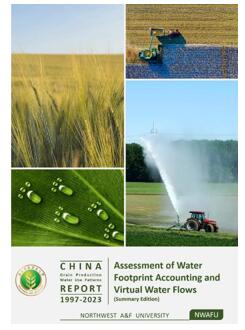 This report, developed by Northwest A&F University (NWAFU) of China, provides a detailed examination of the spatiotemporal evolution of grain production, water footprint (WF), and virtual water flows (VWF) in China from 1997 to 2023. The Water Footprint (WF) refers to the total volume of freshwater used directly and indirectly to produce goods or services. Within WF, Blue Water Footprint (BWF) represents the volume of surface and groundwater consumed, while Green Water Footprint (GWF) signifies the volume of soil water derived from precipitation and utilized by vegetation through evapotranspiration. Virtual Blue Water Flow (VBWF) and Virtual Green Water Flow (VGWF) denote the embedded blue and green water resources, respectively, transferred through trade of agricultural products.
This report, developed by Northwest A&F University (NWAFU) of China, provides a detailed examination of the spatiotemporal evolution of grain production, water footprint (WF), and virtual water flows (VWF) in China from 1997 to 2023. The Water Footprint (WF) refers to the total volume of freshwater used directly and indirectly to produce goods or services. Within WF, Blue Water Footprint (BWF) represents the volume of surface and groundwater consumed, while Green Water Footprint (GWF) signifies the volume of soil water derived from precipitation and utilized by vegetation through evapotranspiration. Virtual Blue Water Flow (VBWF) and Virtual Green Water Flow (VGWF) denote the embedded blue and green water resources, respectively, transferred through trade of agricultural products.
Key findings indicate a notable northward relocation of grain production and associated water consumption across China, with the Northeast region emerging as the dominant water consumer. During the study period, although the total WF of grain production in China increased by 4.7%, both BWF and GWF experienced declines. Notably, the share of GWF within the total WF expanded to 61.4%, highlighting the growing significance of green water resources in China's agricultural sector. Interprovincial grain VWF within China witnessed a substantial 140.8% rise, accompanied by significant growth in both VBWF and VGWF. The Northeast and Huang-Huai-Hai regions of China became the principal net exporters of virtual water, while South China and Southeast China served as the primary importers. The virtual water flow from North to South within China intensified, particularly in terms of VGWF, underscoring the pivotal role of rain-fed agriculture in northern China.
The report highlights challenges such as insufficient water resource endowment, uneven spatial distribution of water and land resources, and diminishing marginal returns in improving water use efficiency. It proposes integrated management strategies for blue and green water use, coordinated management of agricultural water in production and consumption, linkage between international and domestic grain markets, and synergistic water conservation measures to ensure sustainable agricultural development.
Click here to access and download the full document for more detailed information.

